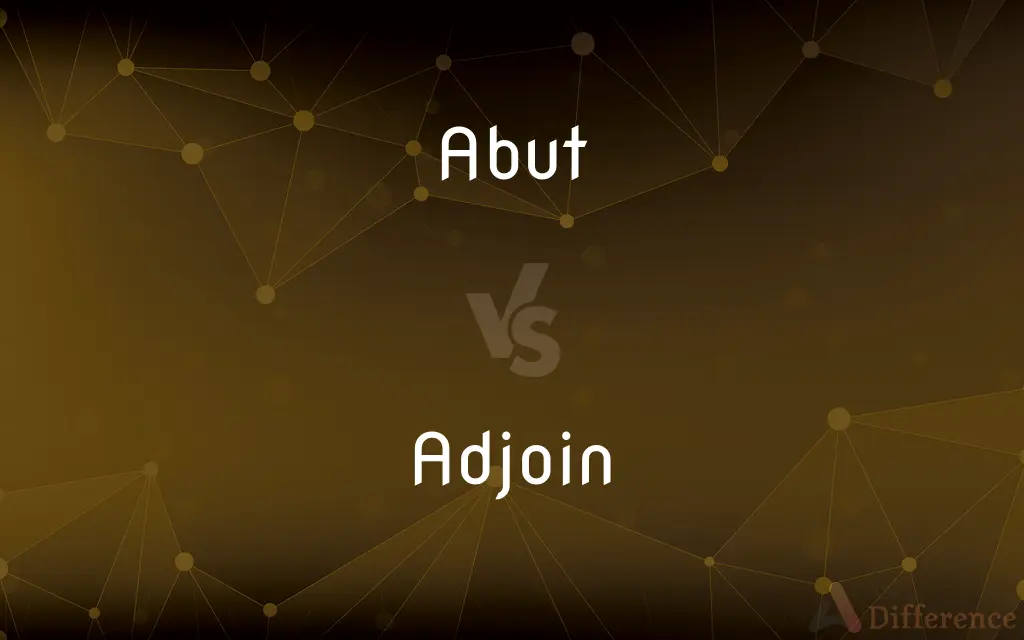Abut vs. Adjoin — What's the Difference?
Edited by Tayyaba Rehman — By Maham Liaqat — Updated on April 2, 2024
"Abut" implies a direct contact or support against an edge, often used in the context of buildings or land, while "adjoin" means to be next to or joined with, highlighting proximity or connection without the necessity of support.

Difference Between Abut and Adjoin
Table of Contents
ADVERTISEMENT
Key Differences
Abut refers to the physical contact or meeting of surfaces, edges, or boundaries, typically suggesting that one object supports or leans against another. This term is often used in construction, real estate, and geography to describe how buildings, land parcels, or other structures directly touch or lean against each other. On the other hand, adjoin signifies a broader concept of being next to or connected with something, which encompasses but is not limited to physical contact. It can indicate a relationship or association between spaces, objects, or areas that are near each other, without the implication of support or pressure.
While "abut" carries a connotation of structural interdependence or support, suggesting a kind of physical reliance or attachment at a point or edge, "adjoin" speaks to spatial or conceptual closeness without implying dependency. For example, a house that abuts another building shares a common wall, thereby implying a direct physical connection, whereas adjoining rooms within a house are simply next to each other, possibly connected by a door.
In legal and property descriptions, "abut" is used to define the precise relationship between boundaries of properties, emphasizing direct contact or a shared boundary line. Conversely, "adjoin" is used in a less strict sense, indicating proximity and can refer to both direct contact and nearness without sharing a boundary.
In essence, while both terms relate to the proximity and arrangement of structures or land, "abut" emphasizes a more specific and structural form of contact, whereas "adjoin" suggests a broader, more relational form of closeness.
Comparison Chart
Definition
To be in direct contact or support
To be next to or connected with
ADVERTISEMENT
Implication
Structural interdependence or support
Spatial or conceptual closeness
Usage Context
Construction, real estate, geography
Spatial arrangement, geography
Legal Significance
Defines precise boundary relationships
Indicates proximity without strict boundaries
Example Usage
Buildings sharing a common wall
Rooms connected by a door
Compare with Definitions
Abut
Indicates a shared boundary.
The two states abut at the river.
Adjoin
Being next to or connected.
The kitchen adjoins the living room.
Abut
Implies structural support.
The retaining wall abuts the garden's edge.
Adjoin
Refers to adjacent areas.
The hotel adjoins the beach.
Abut
Involves physical reliance.
The ancient archway abuts the modern building.
Adjoin
Implies a relational proximity.
The annex that adjoins the main office building.
Abut
Direct contact between structures.
The new extension will abut the existing garage.
Adjoin
Used in layout discussions.
The pool adjoins the patio area.
Abut
Used in precise boundary definitions.
The property abuts the national park.
Adjoin
Indicates spatial closeness.
The two buildings adjoin, sharing a courtyard.
Abut
(of a building or an area of land) be next to or have a common boundary with
Gardens abutting Great Prescott Street
A park abutting on an area of waste land
Adjoin
To be next to; be contiguous to
Property that adjoins ours.
Abut
To touch or end at one end or side; lie adjacent.
Adjoin
To attach
"I do adjoin a copy of the letter that I have received" (John Fowles).
Abut
To border upon or end at; be next to.
Adjoin
To be contiguous.
Abut
To support as an abutment.
Adjoin
(transitive) To be in contact or connection with.
The living room and dining room adjoin each other.
Abut
(intransitive) To touch by means of a mutual border, edge or end; to border on; to lie adjacent (to); to be contiguous (said of an area of land)
It was a time when Germany still abutted upon Russia.
His land abuts on the road.
Adjoin
To extend an algebraic object (e.g. a field, a ring, etc.) by adding to it (an element not belonging to it) and all finite power series of (the element).
can be obtained from by adjoining to .
Abut
(transitive) To border upon; be next to; abut on; be adjacent to.
Adjoin
To join or unite to; to lie contiguous to; to be in contact with; to attach; to append.
Corrections . . . should be, as remarks, adjoined by way of note.
Abut
(intransitive) To lean against on one end; to end on, of a part of a building or wall.
Adjoin
To lie or be next, or in contact; to be contiguous; as, the houses adjoin.
When one man's land adjoins to another's.
Abut
To project; to terminate or border; to be contiguous; to meet; - with on, upon, or against; as, his land abuts on the road.
Adjoin
To join one's self.
She lightly unto him adjoined side to side.
Abut
Lie adjacent to another or share a boundary;
Canada adjoins the U.S.
England marches with Scotland
Adjoin
Lie adjacent to another or share a boundary;
Canada adjoins the U.S.
England marches with Scotland
Adjoin
Be in direct physical contact with; make contact;
The two buildings touch
Their hands touched
The wire must not contact the metal cover
The surfaces contact at this point
Adjoin
Attach or add;
I adjoin a copy of your my lawyer's letter
Common Curiosities
What does it mean for a property to abut another?
For a property to abut another means it directly contacts or supports against it, sharing a common boundary.
Is it possible for two rooms to abut each other?
While two rooms can adjoin (be next to each other), "abut" is less commonly used in this context unless emphasizing a shared wall as a structural support.
Does adjoin always mean there is a physical connection?
Adjoin often implies a physical connection but can also refer to spatial or conceptual closeness without direct physical contact.
Can abut imply legal implications?
Yes, abut can imply legal implications regarding property boundaries and rights due to its emphasis on direct contact or shared boundaries.
How does the term adjoin relate to spatial arrangement?
The term adjoin relates to spatial arrangement by indicating how spaces or structures are positioned in relation to one another, focusing on proximity and connectivity.
Can a garden abut a house?
A garden can abut a house if it directly touches the house’s structure, especially if part of the garden is designed to lean against or support the house's wall.
How does the concept of abut affect architectural design?
Architects must consider structural support and boundary integration when designing buildings that abut others, focusing on stability and legal boundaries.
How is adjoin different from abut?
Adjoin is different from abut in that it implies being next to or connected without necessarily sharing a structural support or direct contact.
How can understanding whether areas abut or adjoin affect property development?
Understanding this can affect development plans, legal boundaries, and design considerations, ensuring proper use of space and adherence to regulations.
What is an example of adjoining structures not sharing a boundary?
An example includes two separate buildings connected by a walkway; they adjoin through the walkway but do not share a direct boundary.
Why is the distinction between abut and adjoin important in real estate?
The distinction is crucial for clarity in legal descriptions, property rights, and in defining the relationships between physical structures on properties.
Can a property adjoin multiple others?
Yes, a property can adjoin multiple others, being next to or connected with several neighboring spaces or structures.
What kind of structures typically abut each other?
Structures that typically abut each other include buildings, walls, or any constructions sharing a common boundary or providing mutual support.
How do abut and adjoin reflect on the use of space?
They reflect the physical and conceptual use of space, indicating how structures interact with each other through direct support or proximity.
What scenarios might require the use of both terms?
Planning and description of complex real estate developments or urban planning scenarios might require the use of both terms to accurately describe spatial relationships.
Share Your Discovery

Previous Comparison
Studies vs. Studied
Next Comparison
Insubstantial vs. SubstantialAuthor Spotlight
Written by
Maham LiaqatEdited by
Tayyaba RehmanTayyaba Rehman is a distinguished writer, currently serving as a primary contributor to askdifference.com. As a researcher in semantics and etymology, Tayyaba's passion for the complexity of languages and their distinctions has found a perfect home on the platform. Tayyaba delves into the intricacies of language, distinguishing between commonly confused words and phrases, thereby providing clarity for readers worldwide.














































